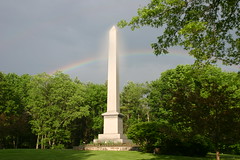_____________________________________________________________
_____________________________________________________________
 Eliza R. Snow served as general president of the Relief Society from 1866 to 1887.
Eliza R. Snow served as general president of the Relief Society from 1866 to 1887.Daughters of Utah Pioneers
Eliza began her pioneer journey from Winter Quarters in June 1847, arriving in the Salt Lake Valley that October. Her powerful gift of literary expression captured the spirit of the Restoration, reflecting the foundational principles of the gospel taught by the Prophet Joseph Smith. She served as the second president of the Relief Society after the Saints arrived in Salt Lake City, figuring prominently in the events of Church history as a womens leader, poet, and writer.
Several of her hymns are Latter-day Saint favorites, including "Behold the Great Redeemer Die", "How Great the Wisdom and the Love", and "O My Father". Forty years after her arrival in the Valley, this remarkable woman passed away on December 5, 1887, at the age of eighty-four. Funeral services were held in the Assembly Hall, after which she was buried in President Brigham Young's family cemetery. Death held no fear, for she viewed it as simply a door leading to the eternal world. She had requested that no black be worn at her funeral, and the Assembly Hall on Temple Square was decked in beautiful white draperies and white flowers.
 Eliza R. Snow was married to Brigham Young and is buried near him in the family cemetery.
Eliza R. Snow was married to Brigham Young and is buried near him in the family cemetery.Kathie and W. Jeffrey Marsh
“O My Father” was written in 1843 while Eliza R. Snow was living in Nauvoo, Illinois. A close friend, Zina D. Huntington (Young), was grieving when it became necessary to move her mother’s body from a temporary grave to a more permanent resting place. When the remains were exhumed, Zina discovered that they were partially petrified. It seemed to Zina as if the very foundation of the doctrine of the Resurrection crumbled. Zina asked the Prophet Joseph Smith, “Shall I know my mother when I meet her in the world beyond?” to which the Prophet responded emphatically, “Yes, you will know your mother there.” Zina D. Huntington was comforted by this promise. From the discussions surrounding such questions on the Resurrection and man’s relationship to Deity, Eliza R. Snow received inspiration to write “O My Father.”
Orson F. Whitney remarked:
“If all her other writings, prose and verse, were swept into oblivion, this poem alone, the sweetest and sublimest of all the songs of Zion, would perpetuate her fame and render her name immortal. But she believed, with Lord Byron, that a poet should do something more than make verses, and she put that belief into practice, laboring incessantly for the promulgation of her religious faith and for the teaching and counseling of the women of her people.”

___________________________________________________________________
___________________________________________________________________
Brigham Young University Religious Education presents
Hallowed Ground Sacred Journeys
Featuring BYU Religious Educators teaching about sites significant in
The Church of Jesus Christ of Latter-day Saints
For more information, or to visit our interactive web site with dozens of additional sites to explore,
please visit VirtualTours.BYU.edu
Hallowed Ground Sacred Journeys
is a co-production of
This blog is a public service of The Watchmen Institute
and is distributed by B.U.M.P. LTD.
All Rights Reserved


0 comments:
Post a Comment